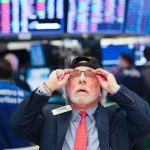Last week President Donald Trump launched a wave of tariffs on almost all goods imported to the United States. Coupled with an initial round of tariffs last month, his actions will place a levy of 10 to 54% on foreign goods. As a result, prices will rise putting financial pressure on most Americans, especially those on low or fixed incomes, such as seniors. Here is where the pain begins.
Like The COVID Crash
The first impact of these broad new tariffs was felt in financial markets where 401Ks and other retirement funds are found.
Trump dubbed his tariff announcements “Liberation Day”. Markets took the opportunity to drop significantly.
Friday, the S&P 500 closed down 6%. The Nasdaq fell 5.8% and the Dow Jones Industrial Average dropped 5.5%. Those declines were the biggest across those markets since the 2020 “COVID Crash”.
“I looked at my 401(k) this morning, and in the last two days, that’s lost $58,000. That’s stressful,” Victor Fettes, who recently retired, told NBC. “If that continues, I can’t stay retired.”
A Tariff Primer
By now, you probably have an idea of what a tariff is. However, a review might be helpful.
Tariffs are a tax on goods brought into one country from another. That makes those goods more expensive for the companies producing them. As a result, those companies usually raise prices to compensate. In turn, those higher prices are passed on to consumers.
Tariffs do not just apply to end products, say automobiles. They apply to component parts, such as batteries, brake pads, electronic controls, and more. As a result, an automobile manufactured in the United States using imported parts will cost more because imported parts will cost more.
Trump argues that tariffs will help the U. S. economy by forcing us to buy American goods. However, Maurice Obstfeld, senior researcher at the Peterson Institute for International Economics, thinks Trump has got it wrong.
“The tariff plan displays a basic misunderstanding of the reasons why nations trade in the first place,” writes Obstfeld, “—reasons that imply the United States will run deficits with some trade partners (bilateral deficits) and surpluses with others (bilateral surpluses). The reasons reflect the operation of comparative advantage. For example, the US imports aluminum from countries that can produce it most efficiently, while embodying it in exports where it has the advantage, such as aircraft. This will tend to lower US trade balances with efficient aluminum producers and raise them with aircraft importers.”
Tariffs Hit Grocery Prices First
The next time you go to the grocery store, you may see the direct result of new tariffs – higher prices.
“Grocery prices will go up,” Andreas Waldkirch, a professor of economics at Colby College, told Today. He expects price hikes will be the first action grocery stores take. However, staff lay-offs could soon follow.
“I think the first thing that they have to do is really to raise prices and then gauge what is the reaction of shoppers,” said Waldkirch.
“Probably almost half of the products in a supermarket — about 40,000 products — will be affected by these tariffs, whether it’s the entire product or just an ingredient,” industry analyst Phil Lempert told NPR.
Even food produced domestically may be impacted by the tariffs. The United States imports about 90% of the potash used to fertilize crops. Canada provides 80% of all the potash used by American farmers. Consequently, the U.S. can not produce enough potash to replace the Canadian supply.
Trump slapped a 25% tariff on Canadian potash in his initial round of tariffs on March 4, only to drop it to 10% two days later.
“A main takeaway here is that the country-specific, food-specific tariffs will not tell the whole story,” said Joseph Balagtas, a professor of agricultural economics at Purdue University.. “This is such a big change in policy that there will be broader implications.”
What Grocery Prices Will Rise First
Generally speaking, fresh imported food prices are likely to rise quickest on tariff price hikes. Some of those include:
- Coffee. Brazil and Colombia account for over 60% of the coffee consumed in the U. S., according to the U. S. Department of Agriculture (USDA). Another 20 per come from other South American countries. All now carry a 10% tariff.
- Seafood. We import about 85% of the fish we eat, according to the National Oceanic and Atmospheric Administration (NOAA). The largest suppliers include Chile with a 10% tariff, India carrying a 26% tariff, Indonesia at a 32% tariff, and Vietnam – a 46% tariff.
- Fruit & Veg. Over 50% of fresh fruit and over 35% of fresh vegetables consumed by Americans are imported. Many suppliers are in Central and South America. Furthermore, all are being charged tariffs of 10%.
- Cheese. While most cheese consumed here is from here (shout-out to Wisconsin) – last year set a record for imports. Over 473 million pounds of cheese were imported in 2024 at a value of $1.94 billion. Moreover, an increase of 12%. Top importers include France, Italy, Spain, and the Netherlands – all subject to the 20% European Union (EU)Tariff.
- Alcohol. Many top international wine producers are located in the EU. That means they face a 20% tariff on their products. In the United Kingdom, beer and whiskey will carry 10% tariffs. Closer to home, Canada and Mexico are dealing with a 25% tariff on beer and spirits.
- Even Beef. About 90% of the beef consumed in America is homegrown. As a result, you might think it is safe from a price hike. However, the nation’s cattle herd is the lowest since 1951. That makes for the classic economic price equation – low supply versus high demand equals higher costs. Plus, if we buy more beef from suppliers in New Zealand and Australia, there will be a 10% tariff added.
Not Just Food
In addition to food, other staples are likely to cost more soon. These items include over-the-counter meds and supplements, cleaning supplies, and pet food and supplies. Not to mention, we are likely to see price hikes on hygiene products, such as bath and hand soap and shampoo.
Some Will Suffer More Than Others
Many Americans spent this weekend wondering if tariff price hikes will allow them to meet their living expenses. Some wondered if the Tariff induced losses to their 401(k)s and pensions will ever be recovered. And as they were – Donald Trump was playing golf..
The fact is that Trump’s tariffs do not impact everyone equally. Low-income families and those on fixed incomes will feel the pain more than most. Because they spend more of their income
on essential needs such as rent/mortgage, food, utilities, and transportation.
Referring to tariffs as a tax, Dipanjan Chatterjee, vice president and principal analyst at Forrester, told the Associated Press:
“That tax is more severe for people who earn less money,” said Chatterjee. “So it’s a regressive tax.”,
Combatting Tariff Price Hikes
There are not a lot of strategies for dealing with the impact of strategies. However, there are a few moves that can be helpful
- Review Your Budget. This may be galling advice if you are already stretched thin financially. However, a review might reveal an expense or two that can be cut or trimmed. You also might find ways to make your budget more comfortable
- Buy Used. Spring is here, and that means yard sales will be kicking into gear. If you inspect items carefully, you can buy a quality item for much less than retail. You can also find bargains at thrift stores and online.
- In Bulk. If you have the money, buying in bulk can offer great savings. However, if you are single or a couple, buying in bulk might mean getting more than you need. If that is the case, it might make sense to team up with neighbors or friends to buy as a group and save.
Read More:
- Why Gen Z Could Become The Richest- And Most Disruptive – Generation Yet
- Direct Primary Care Cuts Inefficiency And Cost To Increase Time Doctors Spend With Patients
- Fighting Rising Prescription Drug Prices
Read the full article here
















